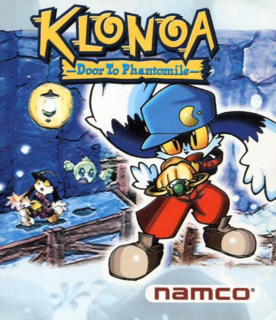Like any great masterpiece, Klonoa and its greatness stand the test of time
What Klonoa does to mark its own territory in the platforming realm is progressing in quite a unique way for a sidescroller, producing an interesting blend of 2-D gameplay with stage design and story development that would be most commonly seen on a 3-D platformer. Klonoa tells the tale of a rabbit-like boy who has constant dreams of witnessing a ship crashing into a nearby hill until, one day, while wondering about what is it that makes dreams so hard to remember, he does see the ship colliding with the mountain. He then decides to go out and investigate, and from that moment on it is time to beat down enemies, perform tricky jumps and explore beautiful new worlds.
What is so special about Klonoa's story development is that it does not follow the usual mold of clearing one uniquely-themed world only to, then, head onto the next land. Instead, the stages taking place in different areas are intercalated, but that is not done in random fashion. At one point, for example, Klonoa wanders into a forest where he must find the chief of a tribe. Unfortunately, when he reaches the end of the stage he finds out, during a cutscene, that the water flow that would allow him to continue his travel has been interrupted. Therefore, before proceeding further into the forest, Klonoa finds the need to travel to the game's watery world to discover what exactly is going on at the land's water source. Little happenings like this occur all throughout the story, and while it might seem like a little detail, it does wonders to stitch together the game in a cohesive manner and allow developers to jump from one world to the other seamlessly.
When it comes to the stages, and that is the area where the game truly shines, they reflect the story's tendency to join aspects of 2-D with 3-D platforming. Klonoa takes place in a 2-D perspective, with the character only being able to move from the left to right. However, its environments provide beautiful 3-D depth, and that depth is not there simply for the value of looks, as it frequently comes into play, interfering with the gameplay. Sometimes Klonoa must use his enemy-grabbing abilities to throw a creature as a projectile onto an item container that is located away in the horizon and, on other occasions, the horizontal extension of the scenarios will end up revealing alternate paths and secret locations that players can reach.
While a few of the game's stages are absolutely linear, some of them are set up like dungeons or explorable environments that are simply set up in a sidescrolling axis. That curious configuration leads to some very impressive stage design along the way, and – for the very short time that it lasts – Klonoa is a game that is always pulling off a few surprises that keep the game very engaging and enchanting all the way through. The character may not have a very vast arsenal of moves - his actions are limited to jumping, picking up enemies with his wind gun, throwing them at other foes, using grabbed enemies to perform tricky double jumps and floating in midair for a little time – but they are very well-used to create interesting platforming situations.
It is certainly a disappointment that the game only features twelve different stages across four different worlds, but a few of those stages are long enough to warrant at least six hours of gameplay for beating the game. For those who are looking for something extra to do once the main action is over, the game does offer some options. On each stage players can encounter six friends who have been locked up by enemy forces, and while some will be naturally found, others require nice investigation of the game's occasionally complex stage setup. In addition, it is a challenge of its own to get the perfect gem count of 150 on each stage. If all creatures are rescued, the game will open up new character costumes, the ability to reverse the stages – greatly increasing the challenge – and even a fun little time trials that will delight speed runners.
Technically, Klonoa is nothing short of impressive. The graphics as bright and colorful as it gets and some of the visual effects, like the wonderful water, are some of the best on the system. The character models are extremely smooth and beautifully animated, and the reworked cutscenes add a lot to the game. Some may be bothered by how frequent they are, as Klonoa puts some focus on storytelling, or how childish they may often be, as they were clearly written with children in mind. However, the fact that the plot does have some quality to it, including some surprisingly dramatic moments, and the ability to skip the scenes right away make them much more bearable. Musically, Klonoa offers very nice tunes and the added voice acting is a nice plus, even if the traditional – and optional - gibberish is preferable and suits the game better.
In the end, the remake of Klonoa: Door to Phantomile reaffirms that game's status as one of the best platformers of its generation – a generation that included Super Mario 64, Banjo-Kazooie, Banjo-Tooie and Rayman 2 – and shows that the game's structure is as timeless as that of any great classic, because even many years after its release, it still manages to be quite impressive.

